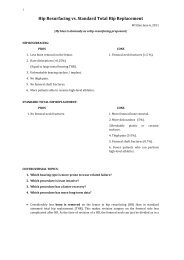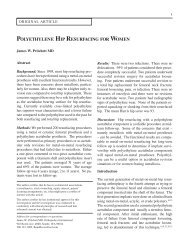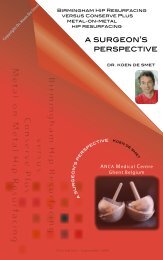Hip and Knee Arthroplasty - Surface Hippy Guide to Hip Resurfacing
Hip and Knee Arthroplasty - Surface Hippy Guide to Hip Resurfacing
Hip and Knee Arthroplasty - Surface Hippy Guide to Hip Resurfacing
Create successful ePaper yourself
Turn your PDF publications into a flip-book with our unique Google optimized e-Paper software.
cumulative percent revision (0.8%) of all stem<br />
<strong>and</strong> acetabular combinations.<br />
There are 36 cementless primary conventional<br />
<strong>to</strong>tal hip stem/acetabular combinations listed with<br />
33 having over 1,000 observed component years.<br />
The number of revisions per 100 observed<br />
component years varies from 0.4 <strong>to</strong> 2.1 revisions,<br />
which is a wider range than for both cemented<br />
<strong>and</strong> hybrid combinations. Four cementless<br />
combinations have less than or equal <strong>to</strong> 0.5<br />
revisions per 100 observed component years.<br />
These are the Citation/ Vitalock, Natural<br />
<strong>Hip</strong>/Fitmore, Secure-Fit Plus/Trident <strong>and</strong> the<br />
Summit/Pinnacle. At seven years the<br />
Citation/Vitalock <strong>and</strong> Secure-Fit/Trident have the<br />
lowest cumulative percent revision for cementless<br />
combinations (2.2%) (Tables HT31 <strong>and</strong> HT32).<br />
There are 22 combinations using hybrid fixation<br />
where the femoral component is cemented <strong>and</strong><br />
the acetabular component is cementless. There<br />
are 18 combinations with over 1,000 observed<br />
component years. The rate of revision per 100<br />
observed component years varies from 0.2 <strong>to</strong> 1.4<br />
revisions (Table HT33). There are three<br />
combinations with 0.2 revisions per 100<br />
component years, the Definition/Vitalock,<br />
Exeter/Mallory-Head <strong>and</strong> the MS 30/Fitmore.<br />
The Definition/Vitalock <strong>and</strong> the Exeter/Mallory-<br />
Head have the lowest cumulative revision rate at<br />
seven years (1.3%) (Table HT34).<br />
Outcome of Total <strong>Resurfacing</strong> <strong>Hip</strong><br />
Replacement<br />
Effect of Age <strong>and</strong> Gender<br />
The cumulative percentage revision for<br />
resurfacing hip replacement increases with<br />
increasing age (Figure HT28). At five years the<br />
cumulative percent revision for patients aged<br />






